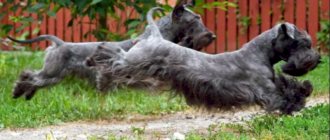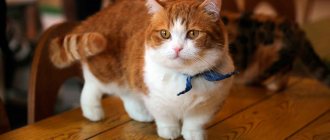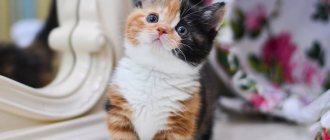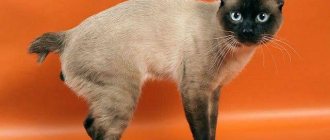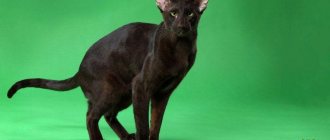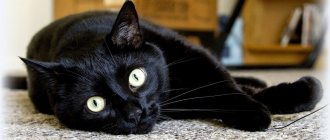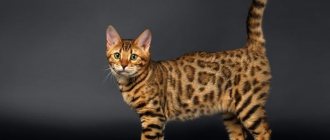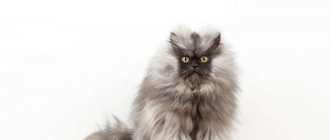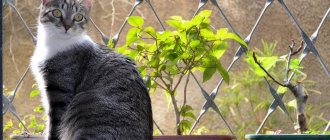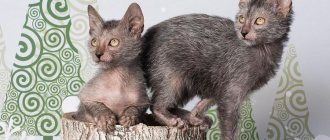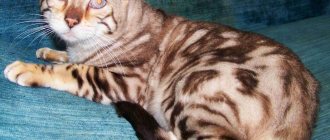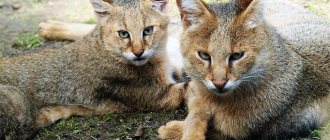Origin story
The breed arose as an unexpected result of the work of breeder Virginia Daley. Initially, it was planned to breed a Siamese cat with a tabby color, for which in 1964 representatives of the Siamese and Abyssinian cats were crossed. However, one of the kittens in the litter was white with golden spots all over its body and looked very much like a wild cat. The baby was named Tongo, and since there were no plans to use a small domestic leopard for breeding, he was castrated and placed in a new home.
However, the breeders soon remembered the interesting kitten. It was decided to repeat the result, but this time the American Shorthair was added during the crossing. Cats from subsequent litters began to be used for breeding, and wild cats also took part in order to consolidate some of the qualities of the breed.
In 1966, the new breed was recognized by the CFA, and after this, in 1987, representatives of the breed took part in the US Championship. In the same year, the breed was officially recognized and registered.
This is interesting! The name Ocicat comes from the name of the wild cat Ocelot, as the appearance of these cats is very similar. But, unlike its wild relatives, the Ocicat is smaller in size and has a more peaceful and calm character.
Gradually, the Ocicat became popular in many countries. These cats came to Europe in the late 1980s. The breed has been registered by many felinological clubs, including ACF, FIFE, TICA WCFCFA, ACFA. Several nurseries have now been opened where these cats are bred. They are mainly located in the USA and France.
Chocolate color option
Description of the breed
Some people, when they see an Ocicat, may confuse it with an ordinary yard cat. At first glance, there are indeed features in their appearance, like the American Shorthair cat, reminiscent of the familiar tabby, spotted cats.
However, the Ocicat has many qualities that are unusual for such pets. These are features of color, physique, size and proportions, style of movement. Now let's look at all these parameters in more detail.
Characteristics of the cat
The Ocicat is a medium-sized cat with a strong, harmonious build. The limbs are long enough to allow deft jumping and running. The joints and ligaments are very flexible, this makes the representatives of the breed flexible and graceful. The movements of these cats are precise and confident. Representatives of the breed have expressive looks and facial expressions, they are emotional and perfectly demonstrate their feelings.
The body of these pets is powerful, but not heavy, which makes the Ocicat strong and elegant. Males are much larger than cats, the difference can be up to two to three kg. Males are more aggressive and dominant in behavior, while females are more docile and affectionate. However, in general the breed is very peaceful and social.
Cat breed British Chinchilla, a long-haired miracle with green eyes and a calm character
A distinctive feature of the Ocicat is its spotted color, like that of wild cats. The color of the coat may vary, but must retain the following characteristics:
- ticking (dark areas on light hair, ring-shaped covering the hair; there may be several such darkened areas on one hair);
- a mark on the forehead in the form of the letter “M”, made up of stripes and spots;
- the tip of the tail gradually darkens and becomes black;
- On the back and sides, clear small spots are arranged in rows.
Unlike its wild ocelot counterparts, the Ocicat is a peaceful and completely social cat. They make wonderful pets for the whole family. The character combines will and independence, sociability and curiosity, affection for the owner, which is inherent in Siamese, Abyssinian and American shorthair cats, from which the Ocicat originated.
This is interesting! There are 12 officially recognized Ocicat colors: from red to gray shades, but there must be regular spots, markings all over the body and lightened areas on the lips, chin, and around the eyes.
Acceptable colors:
- red-brown;
- ginger;
- yellow-brown;
- chocolate;
- milk coffee;
- blue;
- lilac;
- variations of shades with the addition of a silver tint.
The spots are always dark compared to the main background; the color of the nose must match the color.
Exhibition standards
According to the TICA classification, representatives of the breed must meet the following standard requirements:
Head
Neat, wedge-shaped; proportional in size to the body; the muzzle is elongated in profile, but not pointed, quite wide in full face; the jaws are strong, the chin is powerful; the ears are large, with regular angles, located on the border between high and low, which creates the impression of alertness; Tassels on the tips of the ears are welcome.
Eyes
Almond-shaped, set wide apart, may be slightly slanted, expression attentive; Any color is allowed, regardless of coat color, but blue eyes are considered an anomaly.
Neck
Muscular, strong, but graceful and flexible, of medium length.
Blue color
Body
- semi-foreign type of constitution (an average variant between a light, thin physique and a heavy, loose one);
- cats have an athletic body, long, flexible and strong;
- the chest is deep (the elbow is above the level of the sternum), the ribs are rounded, the sides are straight;
- the rise of the back is noted towards the tail;
- the muscles are well developed, the tendons are strong, which ensures high mobility and endurance;
- The bones are strong, but not too heavy.
Limbs
Sufficiently long, proportional to the body, strong; the muscles of the thighs are well defined; paws are oval, compactly assembled, toes tightly clenched;
Tail
Long, tapering to the tip; The color darkens as it moves away from the body, and is black at the tip.
Wool
Short, thick, silky; soft and pleasant to the touch; Each hair should have several ticking zones; spots on the coat should be clear and contrasting.
Weight
An adult cat weighs about 6 - 7 kg, females - 4 - 5 kg.
And here you will find the schedule of WCF cat shows for 2022.
Flaws
Less serious defects include irregularly shaped spots (elongated, unclear) and blue eye color.
Disqualifying faults
- White markings (except for lips, area around eyes, under chin on top of throat).
- Long wool.
- Inappropriate physique.
- Polydactylism (the presence of extra fingers on the limbs. Correctly there should be five fingers on the front limbs and four fingers on the hind limbs).
- Males have cryptorchidism.
- Cowardice and unjustified aggression are also considered vices.
The Ocicat must move correctly (elastically, accurately, gracefully) and show balance of character.
Useful information
The Ocicat is a fairly popular breed among breeders. This is explained by the fact that its representatives have practically no disadvantages, except for the high price. Prices in the nursery for a purebred kitten start from 30 thousand rubles. Show-class kittens can cost more than 100 thousand rubles.
The Ocicat fully justifies its cost, because it combines the beauty and grace of a wild predator with a friendly and loving disposition. Representatives of the breed are highly intelligent and amenable to basic training, bring small objects in their teeth, and perform simple tricks . With good upbringing, they can be accustomed to the owner’s daily routine so that the pet is awake during the day and does not scream in the middle of the night, begging for food. They are unpretentious and do not require special care. All this makes Ocicats excellent companions and loyal four-legged friends.
How to choose a kitten
Ocicats have been very popular among breeders for many years. But in order to purchase a pedigree, purebred animal with excellent health, you must make a purchase exclusively from a specialized nursery with a good reputation. Conscientious breeders do not give away kittens until three months old. It is at this age that the pet is already socially adapted and accustomed to the toilet and scratching post.
When choosing, be sure to pay attention to the appearance of the kitten, the color of the coat and iris, the condition of the hair and mucous membranes. A bloated belly and cloudy eyes may indicate the presence of parasites. It is imperative to check the pedigree, international veterinary passport and vaccinations against panleukopenia, calicivirus infection, rhinotracheitis, rabies and chlamydia.
Suitable age for sterilization (castration)
It is recommended to spay and neuter your Ocicat after the onset of sexual maturity at 8 months, although there are no strict rules for carrying out the operation earlier or later. Breeders prefer to sterilize purebred animals with defects in childhood in order to certainly exclude the possibility of further reproduction.
But it is worth considering that such untimely surgical interventions have a bad effect on the development of the kitten. In some cases, the animal may stop growing.
Beautiful photo
Dark brown color
Lighter color
Ginger cat
Beautiful model photo
Very similar to the wild cat Ocelot
Colors
According to the standard, 12 acceptable colors are established: chocolate, chocolate-silver, brown, brown with red, brown with yellow, brown-silver, lilac, lilac-silver, blue, blue-silver, beige-silver, black with silver.
The spots on the tail, paws and muzzle should be noticeably darker than the marks on the body. There is a letter "M" on the muzzle. The eyes are outlined in black. The tails of purebred individuals have contrasting transverse stripes.
In the photo there are Ocicat cats of popular colors: red, blue-gray, beige
Character
This is a wonderful companion, as the Ocicat is characterized by tenderness and playfulness. These cats become attached to their owner, which is somewhat reminiscent of dogs. Thanks to the high level of intelligence, the Ocicat is easy to teach some tricks; it is only important to choose the right training and find an individual approach to your four-legged friend.
Representatives of the breed have a hard time withstanding loneliness, they try to accompany their beloved owner everywhere, even in a carrying bag, but at the same time they remain very modest and unobtrusive. They will not intrusively demand attention, but are always happy to receive a portion of affection.
The Ocicat will never miss an opportunity to learn something new and will happily take part in exciting games. These cats get along well with other pets and can make friends with rodents, provided that they grow up together so that the hunting instinct does not work.
Warning! Please note that the Ocicat is a very talkative pet, a trait borrowed from the Siamese cats that were used to breed the breed.
The Ocicat will happily loudly greet its owner when he comes home from work, and during games he will emotionally demonstrate his mood. Even when in a calm state, this cat loves to purr and meow, so people who value silence will have to come to terms with this feature of their pet.
Difference between Ocicat and Bengal cat
Diseases
By cat standards, Ocicats live a long life: 15-18 years. But they have genetic problems, which is not surprising: after all, when breeding the breed, as many as 3 breeds of cats were used!
- Firstly, renal amyloidosis is often diagnosed in Ocicats. This disease is quite rare, but very dangerous: the body stops processing protein correctly. Metabolism is disrupted, the kidneys suffer, and renal failure occurs. The animal loses weight, weakens, its urine becomes thick with blood, constipation or diarrhea appears, the temperature rises, the hair becomes dull and falls out. It is impossible to cure the disease, but it is possible to alleviate the cat’s condition, as well as extend life for several years.
- The second problem is pyruvate kinase deficiency (PK-Def) - an autosomal recessive disease, anemia, in other words. Symptoms vary (lack of appetite, weakness, weight loss, drowsiness, spleen tumor). Medicines improve quality of life.
- The third problem is gum disease (gingivitis). It was transmitted to Ocicats from both Abyssinian and Siamese cats. Gingivitis leads to tooth loss, so preventive measures must be followed very strictly.
Expert opinion
Dusheba Vera Ivanovna
In 2010, she graduated from the Moscow State Academy of Veterinary Medicine named after K.I. Scriabin with honors, specializing in veterinary medicine. I regularly attend veterinary conferences, congresses, and webinars.
The deworming procedure should be carried out even if your cat does not go for walks. Worm eggs can enter his body even with food (through chicken, pork, fish), from your outdoor shoes, or through fleas. Medicines should be given only after consultation with a veterinarian, since the age, weight, and general condition of the animal are taken into account (medications should not be given to kittens under 20 weeks of age, and with extreme caution to lactating cats and pregnant women).
All of the above applies to vaccination. Diseases such as panleukopenia, rhinotracheitis, calcivirosis, rabies and others are deadly for cats. For some time, kittens are protected by mother's milk, but when they reach the age of 16 weeks, the effect disappears. Vaccination provides lasting immunity and reliable protection, but you shouldn’t give your cat injections yourself - trust this matter to your doctor!
Differences from the Bengal cat
Outwardly, the Ocicat is very similar to a wild cat, just like representatives of the Bengal breed. It's not surprising that these different pets can be easily confused. However, there are important differences between these cats.
The Bengal arose as a result of crossing a wild Bengal cat with an ordinary domestic cat, while the ancestors of the Ocicat are domestic cat breeds. The physique of representatives of both breeds is also similar, but the features of the muzzle, the size and position of the ears, and the shape of the eyes are different. The Bengal cat's head is somewhat rounder than that of the Ocicat, and the nose is larger.
Perhaps the main distinguishing feature between the Ocicat and the Bengal is the shape and location of the spots. In the latter, large spots are clearly visible on the golden coat, often ring-shaped, and a marbled color is also acceptable. Such colors are unacceptable for the Ocicat.
Catering
Active Ocicats do not suffer from lack of appetite and are not prone to obesity. But this does not mean that you can feed them anything and put huge portions in bowls “in reserve.” The basic rules are:
- Food for the Ocicat should be coarse enough to remove plaque from the teeth and massage the gums.
- Animal protein – at least 70%.
- For castrated and sterilized animals, the amount of carbohydrates should be kept to a minimum.
- Water is the only thing you can give an Ocicat. It must be clean (bottled, settled, or passed through a special filter), at a comfortable temperature, and odorless. Wash the bowl and change the water 2 times a day: morning and evening, and when it gets dirty.
- Do not mix natural and prepared food: this creates additional stress on the digestive system. Choose one thing.
Natural products
You need to be able to choose the right products, prepare them properly, know in what quantities and to whom to give them.
You cannot feed cats food from your table: fatty, sweet, salty foods, it is forbidden to give smoked meats, many vegetables (eggplants, pure potatoes, tomatoes), legumes, juices, citrus fruits, baked goods, canned food, seasonings, sugar, salt, sauces, alcohol, products with preservatives and additives. And chocolate and eggplants are deadly for cats, as are tubular bones!
List of permitted products:
- Fish (salmon, trout, chum salmon, cod, tuna, pink salmon, flounder, halibut, sardine). Scales, fins and heads are removed from the fish, frozen for 2-3 days before consumption, then cut into pieces and boiled or served raw. You can’t give it more than once a week: excess iodine leads to hyperthyroidism, histamine – to allergies, fatty acids – to inflammation and panniculitis.
- Lean meat and offal (beef tenderloin, veal, chicken necks and breasts, rabbit, turkey, kidneys, liver, hearts, horse meat, soft cartilage). Meat, like fish, is frozen and then doused with boiling water or boiled.
- Low-fat dairy products (cottage cheese, fermented baked milk, cream, kefir, yogurt, sour cream, natural yogurt).
- Porridge (buckwheat, oatmeal, pearl barley, millet, rice). Boil in water, do not add sugar, salt or seasonings. You can add milk, but not much (solely for taste).
- Boiled chicken eggs (yolk), quail eggs (whole).
- Vegetables (pumpkin, carrots, zucchini, asparagus, broccoli, green peas, cauliflower, spinach, beets, squash, parsley, green salad, dill, cucumbers).
Recommended food
Industrial ready-made food is often chosen by owners who, due to their busy lives, cannot devote much time to cooking and counting nutrients. But there are so many bright packages on store shelves that it is sometimes difficult to make a choice.
But don't believe the advertising! If you have the financial opportunity, buy holistic food for your pet. They are the most expensive, but the quality is an order of magnitude higher than all the others. For their production, high-quality products, natural preservatives, high-quality vitamin and mineral supplements are used, and there are no dangerous chemical compounds, flavor enhancers or dyes. Examples: Power of Nature, Wellness CORE, Now Fresh.
Super-premium food is a little cheaper. The composition is somewhat different from holistic food: pea or potato protein and rosemary are often added to super-premium food as a preservative. Examples: Mealfeel, Natyka, Pronature Life, Summit.
Below are the recommended holistic and super-premium foods. Links with the names of the food are clickable, on them you can, within our website, get acquainted with the descriptions of the food and read reviews from owners of Ocicat cats.
| Super premium | Holistic | Super premium |
| Pure Life | Alleva Holistic | VetSolution |
Features of maintenance, care, feeding
Since the Ocicat's coat is short and soft, these cats need to be combed with fine combs or short-toothed combs. In general, care is simple and does not require any special wisdom. The Ocicat's coat is short and does not tend to form tangles, which means you don't need a tangle cutter.
Due to their tendency to form plaque, these pets need to have their teeth brushed regularly. The owner should get a special toothbrush, toothpaste or other hygiene products for cats.
Since representatives of the breed are very active cats, it is necessary to equip the house with a play area. This could be a post for sharpening claws, shelves, transitions, other climbing devices, and be sure to provide your pet with toys. Some dog toys are also quite suitable.
A person who spends a lot of time outside the home and cannot pay enough attention to the Ocicat should better think about purchasing a cat of another calmer and lazier breed.
Just like other cat breeds, you will need to trim your claws periodically. A regular nail clipper used in such cases will be quite sufficient.
You will also need to clean your ears no more often than representatives of other similar breeds. If you accustom your kitten to this hygiene procedure in advance, then there should be no problems in the future.
This breed does not require special eye care, but it is better to have everything that is needed at home in stock until your pet turns one year old. As a rule, an adult Ocicat does not have eye problems.
It is necessary to bathe your cat in warm water periodically. Since this breed has short hair, frequent bathing is not necessary, but even a domestic cat needs to be washed 2-3 times a year. Be sure to use a special shampoo, not necessarily expensive.
Description of the LaPerm cat breed and the differences between long-haired and short-haired varieties
Regarding feeding, there are no special rules for this breed. Kittens are perfectly suited to all the standard rules for feeding kittens according to age.
The cat's tray should always be cleanly washed, treated with a special cleaning agent and be in the same place familiar to the pet, otherwise he will arrange a toilet anywhere in the apartment. It is also advisable to use the same type of litter for the litter box to avoid unnecessary stress.
If you don't like the daily, routine work of washing a dirty litter box, try retraining your cat to go to the toilet on the toilet. How to do this, read the special article.
For adult cats, food can be either natural or ready-made branded food, suitable for the age and lifestyle of the cat. It is important to choose high-quality fresh products. Due to the high mobility of the breed, the portions should be voluminous, and the composition should be nutritious and sufficiently high in calories.
It is best to purchase an automatic cat feeder so that you can calmly go to work, knowing that your furry pet will be properly and promptly fed in your absence. We also recommend adding an automatic drinking bowl to the kit to provide him with clean, filtered water.
Education and training
It is customary to write about the learning abilities of Ocicats only that they are smart and quick-witted pets who can easily fetch objects and simple acrobatic tricks. At the same time, it is extremely rare to find information that, like any cats, the descendants of Siamese and Abyssinians are not eager to obey a person and train simply because the owner demands it.
If you decide to get serious about training your Ocicat, come to terms with the need for compromises, which you will have to make often. Some breeders generally recommend relying on the inclinations of the breed, since by stimulating the cat to do what he obviously likes, you dramatically increase your chances of success. For example, Ocicats love to jump, which means that it will not be difficult to teach your pet to take small barriers and fly through a hoop.
The Ocicat has a good memory and excellent self-learning abilities, inherited from the Abyssinians, so the cat quickly learns a list of basic commands. In order for your pet to learn to comply with the requirements “Come to me!”, “Sit!”, “Stand!”, a classic training program is sufficient. Special literature, for example, the book “Training a Cat in 10 Minutes” by Miriam Fields-Bambino or “How to Train Your Cat” by Ellis Bradshaw, will also help you broaden your horizons and learn new techniques for effectively influencing an animal.
Raising a small kitten is easier when a trained adult cat already lives in the house. Submitting to the animal hierarchy, the baby mirrors the behavior of an adult comrade and makes fewer mistakes. If the Ocicat is the only pet in the apartment, the owner will have to take on the role of mentor. As for toilet training your pet, there are no difficulties here. Michigan cats are naturally clean. If there is no usual litter box nearby (for example, on the road), they prefer to be patient or persistently remind them of their needs. Ocicat kittens brought to a new home also quickly get used to the bath with filler and willingly scratch themselves in it, hiding traces of “wet deeds.”
Health and life expectancy
In general, the breed is very strong and has a stable immune system. However, sometimes there are diseases adopted from Siamese, American Shorthair and Abyssinian cats. For example, hypertrophic cardiomyopathies, metabolic disorders, blood disorders. In particularly severe cases, circulatory disorders can cause death in young cats. But these cases are rare and are rather exceptional than regular.
For your information! It is useful to undergo regular scheduled examinations with a veterinarian to know the health status of your pet. It is also necessary to carry out annual vaccinations and regular treatments against external and internal parasites.
Thanks to good health and a strong body, the life expectancy of the Ocicat is on average 15 – 17 years, but with proper care, representatives of the breed often live longer.
Pedigree kittens from the nursery
Cost of a kitten
This is a fairly rare breed for Russia. Nurseries are mostly located in the United States of America and there are a few in France.
A few breeders in Russia will rarely sell even a pet-class kitten for a price below thirty thousand rubles.
If you choose a show animal or breed class, you should definitely inquire about the absence of hereditary diseases and developmental defects in its parents. Special laboratory testing may need to be done.
These individuals will cost much more. They must be accompanied by a purchase and sale agreement, a pedigree and a veterinary passport indicating deworming marks and stamps from the state veterinary clinic on vaccinations against rabies and known viral infections.
Ocicat photo gallery:
1111
Breeding Features
Ocicats produce offspring in the same way as other domestic cats. Pregnancy lasts typically 56–64 days. However, there is a peculiarity of the litter - usually only three kittens are born to a cat, and males are born much more often than females.
There may be a lack or deficiency of colostrum in the mother cat. In this case, a special cat milk substitute will come to the rescue.
Immediately provide the correct feeding regime and diet for your pregnant cat. In this case, you can be sure of healthy offspring.
Kittens develop very quickly and instantly absorb new information. Therefore, they need to undergo socialization as early as possible, and also begin to learn house rules at a young age.
Young Ocicats are hyperactive, follow the cat and the owner everywhere, and have a lively mind and imagination. Kittens are often found in unexpected places, for example, in a closet, in clothes, or in other various secluded places, but representatives of the breed have a special love for the tops. As soon as the Ocicat learns to control its body well, it immediately begins to master high shelves, doors and other similar high places.
Advantages and disadvantages
The Ocicat is a very remarkable breed; many cat lovers want to have just such a cat. The advantages of Ocicat include:
- devotion to the owner;
- sharp, lively mind;
- playfulness;
- gentle and affectionate disposition;
- modesty;
There are some disadvantages:
- excessive noise;
- tendency to climb onto all sorts of high places;
- Dependence on the company, demanding attention.
This breed is suitable for keeping in a house with children or other animals, but older people, as well as those who work for a long time, should not have an Ocicat, as these cats get bored, worried and sad when left alone for a long time.
If you like this breed, you can visit the International Cat Show Spring 2022 in Perm.
Feeding the cat
Ocicats need a complete and balanced diet. Many breeders recommend giving them premium or super premium drying and be sure to pay attention to the composition. It is important that there is no wheat, soy, corn, dyes or preservatives. The following brands of products are optimal for feeding Ocicats:
- Brit Care;
- Farmina;
- Hills;
- Bosch;
- Grandorf.
Natural food for a spotted cat should consist mainly of fresh, lean meat. Also included in the Ocicat menu:
- porridge;
- offal;
- vegetables;
- eggs;
- sour milk;
- ocean and sea fish.
It is strictly forbidden to feed Ocicats with sweets, baked goods, pork, sausage, smoked meats and bones. Also, river fish, whole milk, starchy vegetables and any food from the owner’s table are excluded from the spotted cat’s diet.
Interesting Facts
- These cats love to walk on a leash and take a harness well. like another, similar Toyger breed;
- despite its exotic wild appearance, the Ocicat has a peaceful, domestic disposition;
- Ocicats are excellent hunters and also easily learn various commands;
- Whenever possible, representatives of the breed try to climb as high as possible, be it shelves, doors or curtains.
Diseases of the Ocicat cat breed
The genetic pool and potential of representatives of this breed is quite good, and cats rarely get sick.
However, even such a hardy and healthy group is characterized by a number of specific diseases:
- Hypertrophy of the heart muscle, which is accompanied by the development of heart failure.
- Renal amyloidosis, which is manifested by sudden weight loss, constant thirst, and problems with urination.
Another genetically determined disease is a deficiency of a number of oxidative enzymes, which can be suspected when there is a decrease in appetite with a simultaneous enlargement of the abdomen.
Selection of kittens in Russia and abroad
Having decided to get an Ocicat, first of all, it is better to pay attention to professional nurseries; it is extremely undesirable to take the baby “from your hands” or in the market. Ideally, you would invite a veterinarian or a qualified breeder with you; however, by following the following tips, you can easily choose a healthy, high-quality kitten.
It is important to pay attention to the place of detention: it must be spacious enough, always clean and warm, well ventilated. Also collect information about the parents: age, whether there are congenital or acquired diseases, the presence of vaccinations and other planned preventive treatments, the number and characteristics of the resulting offspring, merits in competitions, if any.
If all criteria are met, you can proceed directly to examining the kittens. They should be well-fed, active, the coat should be smooth, shiny, and clean. Pay attention to the eyes, nose, ears, and also the area under the tail. In healthy cats, these areas are clean, without discharge, irritation or damage. Visible mucous membranes should be pink and moist, also without damage.
Healthy kittens are playful, active, do not show cowardice, and have a good appetite. It is important to evaluate the behavior of the kitten you like in the group - what position it occupies in society, whether it is a leader or not, whether it shows aggression or, on the contrary, is docile. Having obtained a general idea of the behavior and health of young Ocicats, you can choose one of them and take your new friend home.
Price
Now a few words about how much a purebred kitten costs. The main places for purchasing these are the USA, France, and other Western countries, but in Russia there are also several professional nurseries of this breed. Prices for kittens vary: from 15,000 rubles to 60,000 rubles.
Ocicat price
In Germany and the rest of Europe, the cost of a breed Ocicat varies from 800 to 1,500 euros (approximately 55,000 - 100,000 rubles). To purchase a kitten in its homeland, the USA, you will have to spend about 500-800 dollars if the animal has a good exterior, and about 150 dollars if the animal has minor defects in appearance and one of the most common coat colors. In Russia, you need to look for Ocicats from breeders involved in breeding rare and exotic cats - single-breed nurseries in the country are still in great short supply. The approximate cost of a pet-class kitten with documents and a clean pedigree from domestic sellers is 35,000 rubles and more.
